ESP CITROEN C5 AIRCROSS 2020 Handbook (in English)
[x] Cancel search | Manufacturer: CITROEN, Model Year: 2020, Model line: C5 AIRCROSS, Model: CITROEN C5 AIRCROSS 2020Pages: 292, PDF Size: 8.59 MB
Page 158 of 292

156
Operating limits
The Active Lane Keeping Assist system
may issue an alert when the vehicle
is travelling in a long straight lane on
a
smooth road sur face even if the driver is
holding the steering wheel properly.
The system may fail to operate or may produce
unsuitable corrections to the steering in the
following situations:
-
P
oor visibility (insufficient road lighting,
snowfall, rain, fog).
-
D
azzle (headlamps of an oncoming vehicle,
low sun, reflections on a
wet road sur face,
leaving a
tunnel, alternating light and
shade).
-
W
indscreen area in front of the camera
being dirty, misted up, frost-covered, snow-
covered, damaged or masked by a
sticker.
-
L
ane markings eroded, partially hidden
(snow, mud) or multiple (roadworks, sur face
j o i nt s).
-
T
ravelling in a tight bend.
-
W
inding roads.
-
P
resence of a tarmac joint on the road. The system must not be activated in the
following situations:
-
D riving with a "space-saver" type
spare wheel.
-
W
hen towing, especially with an
unconnected or unapproved trailer.
-
P
oor weather conditions.
-
D
riving on slippery road sur faces (risk
of aquaplaning, snow, ice).
-
D
riving on racing circuits.
-
D
riving on a rolling road.
Recommendations on care
- Regularly check that the front bumper and the area of the windscreen located in front
of the camera are clean.
-
R
egularly check that the windscreen wipers
are in good condition.
-
I
n bad weather, or during the winter, ensure
that the front bumper and windscreen are
not covered with mud, ice or snow.
Malfunctions
(orange
colour) A system malfunction is indicated
by the Ser vice warning lamp
coming on and this (orange) symbol,
accompanied by an alert message
and an audible signal.
Active Safety Brake with
Collision Risk Alert and
Intelligent emergency
braking assistance
Refer to the General recommendations on
the use of driving and manoeuvring aids
.
This system allows:
-
t
he driver to be warned that their vehicle is
at risk of collision with the vehicle in front,
a pedestrian or, depending on version, a
cyclist,
-
a c
ollision to be prevented, or its severity to
be limited, by reducing the vehicle's speed.
Driving
Page 164 of 292

162
Driving situations and
associated alerts
The table below describes the alerts and
messages displayed depending on the driving
situations.
The display of these alerts is not sequential. While the direction indicators are on and for
a few seconds after switching them off, the
system considers that any change of trajectory
is voluntary and no correction is triggered
during this period.
However, with the Blind Spot Monitoring system
activated, if the driver starts changing lanes
and another vehicle is detected in the vehicle's
blind spot, the system will correct the trajectory
of the vehicle even though the direction
indicators are on.
For more information on the Blind Spot
Monitoring system , refer to the corresponding
section. Status of the
function
Indicator
lampDisplay and/
or associated
message
Comments
OFF
(grey)System deactivated.
ON (grey)System active, conditions not met:
-
s
peed below 40 mph (65 km/h),
-
n
o lane marking recognised,
-
A
SR /DSC systems deactivated
or regulation by ESC system in
progress,
-
"
sporty" driving.
ON
(grey)Automatic deactivation/standby of the
system (e.g. detection of a trailer, use of
the "space-saver" spare wheel provided
with the vehicle).
Driving
Page 167 of 292

165
This system warns the driver of the presence
of another vehicle in the blind spots of their
vehicle (areas hidden from the driver's field
of vision), as soon as this presents a potential
danger.
A fixed warning lamp appears in the door mirror
on the side in question:
-
i
mmediately, when being overtaken,
-
a
fter a delay of about one second, when
overtaking a
vehicle slowly.
In addition to the fixed warning lamp in the door
mirror on the side in question, a correction of
trajectory will be felt if you attempt to cross
a
lane marking with the direction indicator
activated, to help you avoid a
collision.This driving aid system is designed to
improve safety when driving and is in no
circumstances a
substitute for the use
of the interior rear view mirror and door
mirrors. It is the driver's responsibility to
constantly check the traffic, to assess the
relative distances and speeds of other
vehicles and to anticipate their movements
before deciding whether to change lane.
Activation/Deactivation
The function is activated and
deactivated in the Driving/Vehicle
menu of the touch screen.
The state of the system stays in the memory
when switching off the ignition.
The system is automatically deactivated
when towing with a
towing device
approved by CITROËN.
Operation
The alert is given by an orange warning lamp
coming on in the relevant door mirror, as soon
as a
vehicle – car, lorry, bicycle – is detected.
A correction of trajectory will be felt if you
attempt to cross a
lane marking with the
direction indicator flashing.
The following conditions must be met for this:
-
a
ll vehicles are moving in the same direction
and in adjacent lanes,
-
t
he speed of the vehicle must be between
7
and 87 mph (12 and 140 km/h) for the
alert and between 40
and 87 mph (65 and
140
km/h) for a correction of trajectory,
-
t
he system must be activated to trigger
a
change of trajectory,
-
y
ou overtake a vehicle with a speed
difference of less than 6
mph (10 km/h),
-
a v
ehicle overtakes you with a speed
difference of less than 16
mph (25 km/h),
-
t
he traffic is flowing normally,
-
ov
ertaking a vehicle over a certain period
of time and the vehicle being overtaken
remains in the blind spot,
-
y
ou are driving on a straight or slightly
curved road,
-
y
our vehicle is not towing a trailer, a
caravan, etc.
Sensors fitted in the front and rear bumpers
monitor the blind spots.
6
Driving
Page 170 of 292
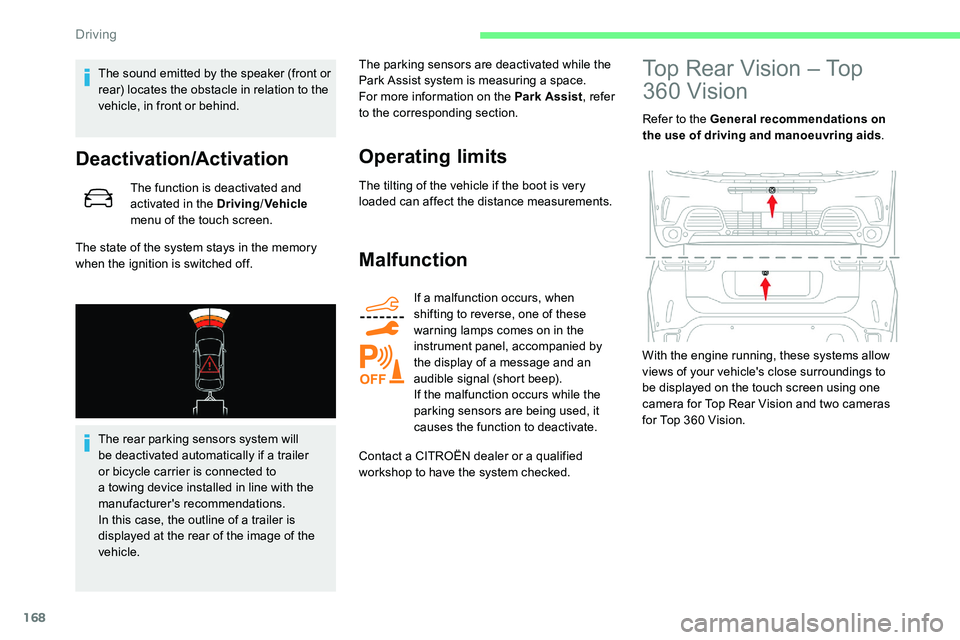
168
The sound emitted by the speaker (front or
rear) locates the obstacle in relation to the
vehicle, in front or behind.
Deactivation/Activation
The function is deactivated and
activated in the Driving/Vehicle
menu of the touch screen.
The state of the system stays in the memory
when the ignition is switched off.
The rear parking sensors system will
be deactivated automatically if a
trailer
or bicycle carrier is connected to
a
towing device installed in line with the
manufacturer's recommendations.
In this case, the outline of a
trailer is
displayed at the rear of the image of the
vehicle. The parking sensors are deactivated while the
Park Assist system is measuring a
space.
For more information on the Park Assist , refer
to the corresponding section.
Operating limits
The tilting of the vehicle if the boot is very
loaded can affect the distance measurements.
Malfunction
If a malfunction occurs, when
s hifting to reverse, one of these
warning lamps comes on in the
instrument panel, accompanied by
the display of a
message and an
audible signal (short beep).
If the malfunction occurs while the
parking sensors are being used, it
causes the function to deactivate.
Contact a
CITROËN dealer or a qualified
workshop to have the system checked.
Top Rear Vision – Top
360
Vision
Refer to the General recommendations on
the use of driving and manoeuvring aids .
With the engine running, these systems allow
views of your vehicle's close surroundings to
be displayed on the touch screen using one
camera for Top Rear Vision and two cameras
for Top 360
Vision.
Driving
Page 172 of 292
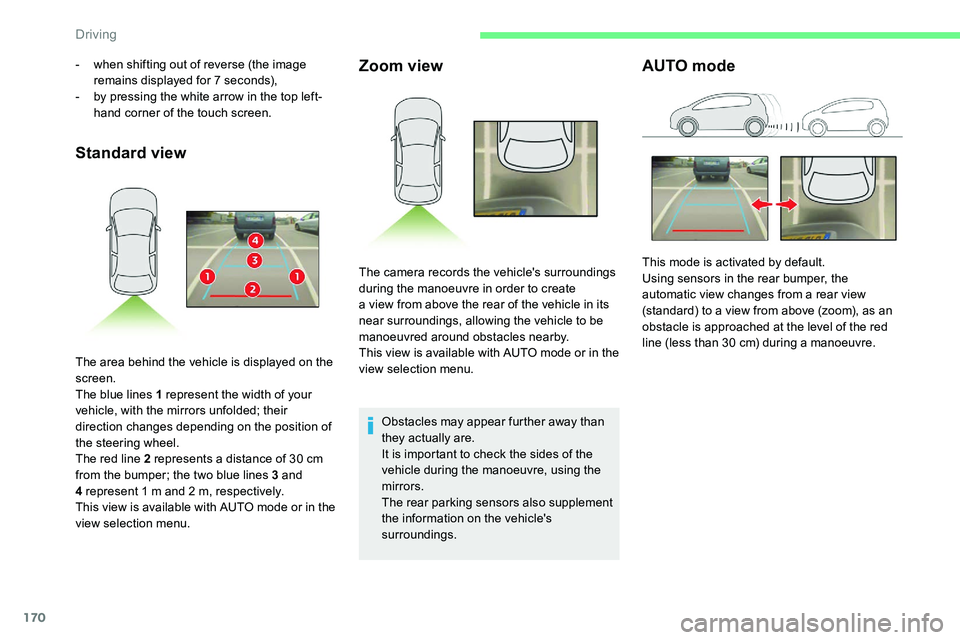
170
Standard viewZoom view
Obstacles may appear further away than
they actually are.
It is important to check the sides of the
vehicle during the manoeuvre, using the
mirrors.
The rear parking sensors also supplement
the information on the vehicle's
surroundings.
AUTO mode- when shifting out of reverse (the image
remains displayed for 7 seconds),
-
b
y pressing the white arrow in the top left-
hand corner of the touch screen.
The area behind the vehicle is displayed on the
screen.
The blue lines 1
represent the width of your
vehicle, with the mirrors unfolded; their
direction changes depending on the position of
the steering wheel.
The red line 2
represents a distance of 30 cm
from the bumper; the two blue lines 3
and
4
represent 1 m and 2 m, respectively.
This view is available with AUTO mode or in the
view selection menu. The camera records the vehicle's surroundings
during the manoeuvre in order to create
a
view from above the rear of the vehicle in its
near surroundings, allowing the vehicle to be
manoeuvred around obstacles nearby.
This view is available with AUTO mode or in the
view selection menu. This mode is activated by default.
Using sensors in the rear bumper, the
automatic view changes from a
rear view
(standard) to a
view from above (zoom), as an
obstacle is approached at the level of the red
line (less than 30
cm) during a manoeuvre.
Driving
Page 173 of 292

171
180° viewTop 360 Vision
The vehicle has a camera at the front, fitted
i n the grille, and a camera at the rear, located
close to the number plate lamps.
Using these cameras, the system displays
the vehicle's near surroundings on the touch
screen, offering views from the rear of the
vehicle (rear vision), when reverse gear is
engaged and views from the front of the vehicle
(front vision), when the gearbox is in neutral or
a
gear is engaged.
Rear vision
If a trailer or a bicycle carrier is fitted to
t he towball, the area behind the vehicle on
the view from above goes dark.
The surroundings are reconstructed by the
front camera only.
The 180° view facilitates reversing out of
a
parking bay, making it possible to see the
approach of vehicles, pedestrians and cyclists.
This view is not recommended for carrying out
a
complete manoeuvre.
It consists of 3
areas: left A , centre B and
right C .
This view is available only from the view
selection menu.
The system activates automatically when
reverse gear is engaged.
The system is deactivated:
-
a
utomatically above about 6
mph (10
km/h), -
w
hen shifting out of reverse (the rear view
image is replaced by the front view image
after 7
seconds),
-
b
y pressing the white arrow in the top left-
hand corner of the touch screen.
The rear vision views are similar to those for
the Top Rear Vision.
For more information on the Top Rear Vision,
refer to the corresponding section.
Front and rear vision
6
Driving
Page 174 of 292
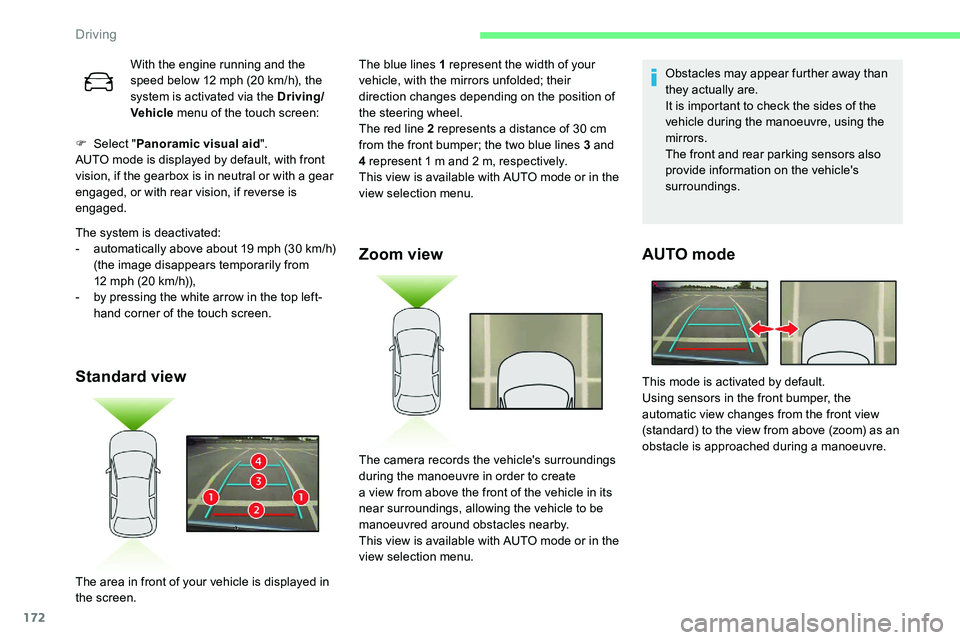
172
F Select "Panoramic visual aid ".
AUTO mode is displayed by default, with front
vision, if the gearbox is in neutral or with a
gear
engaged, or with rear vision, if reverse is
engaged.
The system is deactivated:
-
a
utomatically above about 19 mph (30 km/h)
(the image disappears temporarily from
12
mph (20 km/h)),
-
b
y pressing the white arrow in the top left-
hand corner of the touch screen.
Standard view Zoom view
Obstacles may appear further away than
they actually are.
It is important to check the sides of the
vehicle during the manoeuvre, using the
mirrors.
The front and rear parking sensors also
provide information on the vehicle's
surroundings.
AUTO mode
With the engine running and the
speed below 12
mph (20 km/h), the
system is activated via the Driving/
Vehicle menu of the touch screen: The blue lines 1
represent the width of your
vehicle, with the mirrors unfolded; their
direction changes depending on the position of
the steering wheel.
The red line 2
represents a distance of 30 cm
from the front bumper; the two blue lines 3
and
4
represent 1 m and 2 m, respectively.
This view is available with AUTO mode or in the
view selection menu.
The area in front of your vehicle is displayed in
the screen. The camera records the vehicle's surroundings
during the manoeuvre in order to create
a
view from above the front of the vehicle in its
near surroundings, allowing the vehicle to be
manoeuvred around obstacles nearby.
This view is available with AUTO mode or in the
view selection menu. This mode is activated by default.
Using sensors in the front bumper, the
automatic view changes from the front view
(standard) to the view from above (zoom) as an
obstacle is approached during a
manoeuvre.
Driving
Page 176 of 292
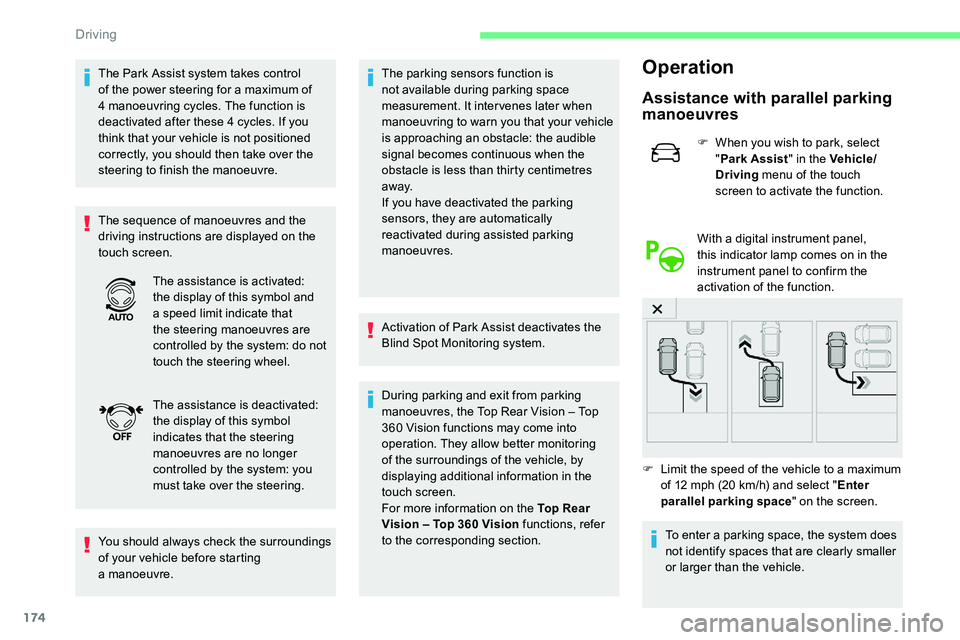
174
The Park Assist system takes control
of the power steering for a maximum of
4
manoeuvring cycles. The function is
deactivated after these 4
cycles. If you
think that your vehicle is not positioned
correctly, you should then take over the
steering to finish the manoeuvre.
The sequence of manoeuvres and the
driving instructions are displayed on the
touch screen.
You should always check the surroundings
of your vehicle before starting
a
manoeuvre. The parking sensors function is
not available during parking space
measurement. It intervenes later when
manoeuvring to warn you that your vehicle
is approaching an obstacle: the audible
signal becomes continuous when the
obstacle is less than thirty centimetres
away.
If you have deactivated the parking
sensors, they are automatically
reactivated during assisted parking
manoeuvres.
Activation of Park Assist deactivates the
Blind Spot Monitoring system.
During parking and exit from parking
manoeuvres, the Top Rear Vision – Top
360
Vision functions may come into
operation. They allow better monitoring
of the surroundings of the vehicle, by
displaying additional information in the
touch screen.
For more information on the Top Rear
Vision – Top 360
Vision functions, refer
to the corresponding section.Operation
Assistance with parallel parking
manoeuvres
F When you wish to park, select "Park Assist " in the Vehicle/
Driving menu of the touch
screen to activate the function.
With a
digital instrument panel,
this indicator lamp comes on in the
instrument panel to confirm the
activation of the function.
F
L
imit the speed of the vehicle to a maximum
of 12
mph (20 km/h) and select " Enter
parallel parking space " on the screen.
The assistance is activated:
the display of this symbol and
a
speed limit indicate that
the steering manoeuvres are
controlled by the system: do not
touch the steering wheel.
The assistance is deactivated:
the display of this symbol
indicates that the steering
manoeuvres are no longer
controlled by the system: you
must take over the steering.
To enter a
parking space, the system does
not identify spaces that are clearly smaller
or larger than the vehicle.
Driving
Page 182 of 292
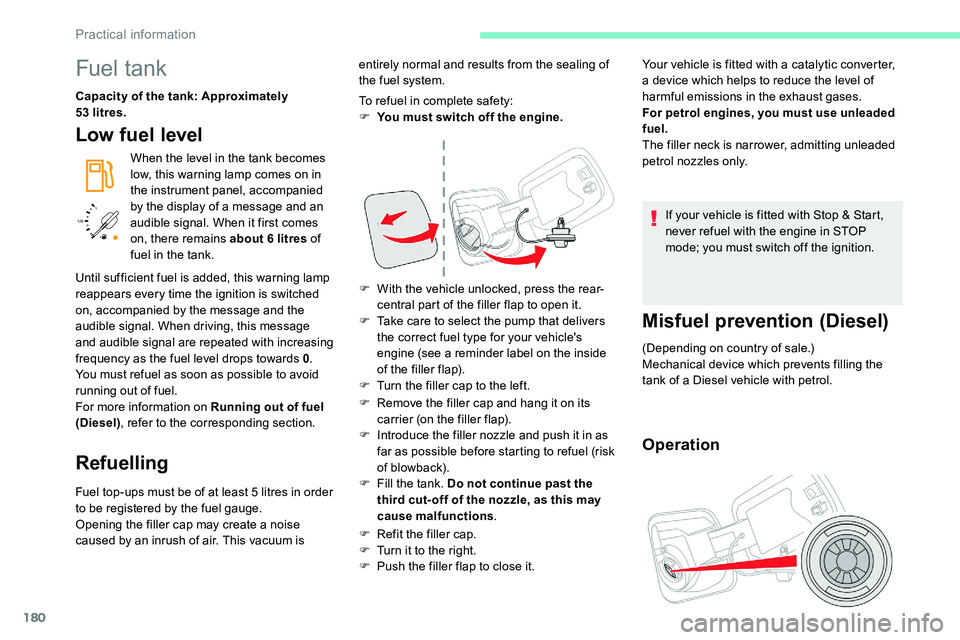
180
/2
1 1
Fuel tank
Capacity of the tank: Approximately
53
litres.
Low fuel level
When the level in the tank becomes
low, this warning lamp comes on in
the instrument panel, accompanied
by the display of a
message and an
audible signal. When it first comes
on, there remains about 6
litres of
fuel in the tank.
Refuelling
Fuel top-ups must be of at least 5 litres in order
t o be registered by the fuel gauge.
Opening the filler cap may create a
noise
caused by an inrush of air. This vacuum is To refuel in complete safety:
F
Y
ou must switch off the engine.
F
W
ith the vehicle unlocked, press the rear-
central part of the filler flap to open it.
F
T
ake care to select the pump that delivers
the correct fuel type for your vehicle's
engine (see a reminder label on the inside
of the filler flap).
F
T
urn the filler cap to the left.
F
R
emove the filler cap and hang it on its
carrier (on the filler flap).
F
I
ntroduce the filler nozzle and push it in as
far as possible before starting to refuel (risk
of blowback).
F F ill the tank. Do not continue past the
third cut- off of the nozzle, as this may
cause malfunctions .
F
R
efit the filler cap.
F
T
urn it to the right.
F
P
ush the filler flap to close it.Your vehicle is fitted with a
catalytic converter,
a device which helps to reduce the level of
harmful emissions in the exhaust gases.
For petrol engines, you must use unleaded
fuel.
The filler neck is narrower, admitting unleaded
petrol nozzles only.
If your vehicle is fitted with Stop & Start,
never refuel with the engine in STOP
mode; you must switch off the ignition.
Misfuel prevention (Diesel)
(Depending on country of sale.)
Mechanical device which prevents filling the
tank of a Diesel vehicle with petrol.
Operation
Until sufficient fuel is added, this warning lamp
reappears every time the ignition is switched
on, accompanied by the message and the
audible signal. When driving, this message
and audible signal are repeated with increasing
frequency as the fuel level drops towards 0 .
You must refuel as soon as possible to avoid
running out of fuel.
For more information on Running out of fuel
(Diesel) , refer to the corresponding section. entirely normal and results from the sealing of
the fuel system.
Practical information
Page 183 of 292
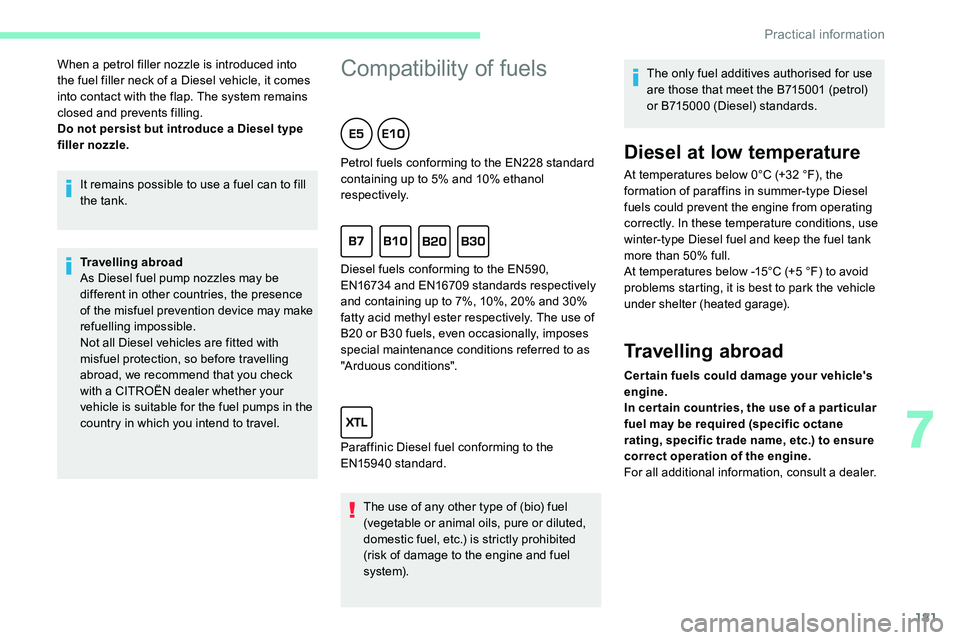
181
It remains possible to use a fuel can to fill
t he tank.
Travelling abroad
As Diesel fuel pump nozzles may be
different in other countries, the presence
of the misfuel prevention device may make
refuelling impossible.
Not all Diesel vehicles are fitted with
misfuel protection, so before travelling
abroad, we recommend that you check
with a
CITROËN dealer whether your
vehicle is suitable for the fuel pumps in the
country in which you intend to travel.
When a
petrol filler nozzle is introduced into
the fuel filler neck of a Diesel vehicle, it comes
into contact with the flap. The system remains
closed and prevents filling.
Do not persist but introduce a Diesel type
filler nozzle.
Compatibility of fuels
The use of any other type of (bio) fuel
(vegetable or animal oils, pure or diluted,
domestic fuel, etc.) is strictly prohibited
(risk of damage to the engine and fuel
syste m). The only fuel additives authorised for use
are those that meet the B715001 (petrol)
or B715000 (Diesel) standards.
Petrol fuels conforming to the EN228 standard
containing up to 5% and 10% ethanol
respectively.
Diesel fuels conforming to the EN590,
EN16734 and EN16709 standards respectively
and containing up to 7%, 10%, 20% and 30%
fatty acid methyl ester respectively. The use of
B20
or B30 fuels, even occasionally, imposes
special maintenance conditions referred to as
"Arduous conditions".
Paraffinic Diesel fuel conforming to the
EN15940
standard.
Diesel at low temperature
At temperatures below 0°C (+32 °F), the
formation of paraffins in summer-type Diesel
fuels could prevent the engine from operating
correctly. In these temperature conditions, use
winter-type Diesel fuel and keep the fuel tank
more than 50% full.
At temperatures below -15°C (+5 °F) to avoid
problems starting, it is best to park the vehicle
under shelter (heated garage).
Travelling abroad
Cer tain fuels could damage your vehicle's
engine.
In cer tain countries, the use of a
par ticular
fuel may be required (specific octane
rating, specific trade name, etc.) to ensure
correct operation of the engine.
For all additional information, consult a
dealer.
7
Practical information